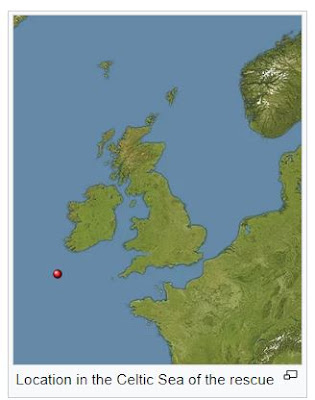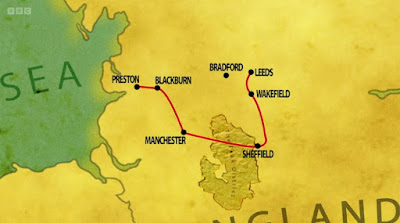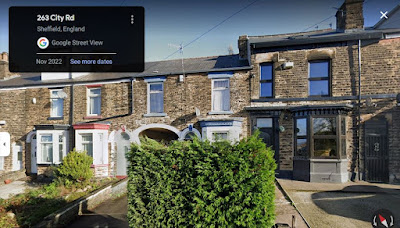It's our dear daughter Sarah's 46th birthday today, and the first time for 7 years that she's celebrated it in the UK, after the years she and her family spent in Australia. As Lois and I always say, you really become 100% sure that you're old when your children become middle-aged, or middle-aged-ish: yikes!
flashback to June 2021: Sarah, with the twins, celebrating her 44th birthday
9000 miles away, in Perth, Australia
I feel a certain bond with Sarah - quite apart from being her father in general haha! - for having been also there to watch her being born, in June 1977, in the old St Paul's Maternity Hospital in Cheltenham. I had wanted to be present also to see her sister Alison's birth 2 years earlier, in August 1975, but I had to withdraw from the room when the birth turned out to be a "forceps job", so fair enough!
I can still remember vividly after Sarah had been just born, her being laid for a brief moment on the bed next to Lois's with her little eyes flashing round the room - awwwww!!!! What a pity none of us ever remembers that moment in our own lives - the moment we come out into the world.
flashback to 1977: me holding little Sarah, and Lois with little Alison,
in the back yard of our little terraced house in Cheltenham - awwwww (again) !!!!
and in the same back yard a year later - 1978
.. and in our new "posh" back garden, 1980, with the kite I had bought for them
in the Space Museum, during a work trip to Washington DC
flashback to Christmas Day 1981 - Sarah in the old Battledown Children's Hospital,
where she had to spend Christmas because of a nasty eye infection.
She's clutching the doll presented to her that morning by the town mayoress:
I had stayed the night there with Sarah: she was one of the only 2 patients there...
... and a few days later, home again, Sarah managing a brave smile
as she sits with Alison by our Christmas tree after her discharge from hospital
Another strong memory I have of Sarah is when our family flew out to the States in 1982 for my 3-year
stint working over there. Lois and I were hoping that the 5-year-old Sarah would fall asleep on the plane, but she kept herself stubbornly awake, and having to be entertained, for the whole flight, only falling asleep as we touched down, so that I had to carry her in my arms, off the plane, into the airport building, through customs, and into the New World.
Awwww, bless her!!!!!
1983 - our first full year in the US, outside our house in Columbia Maryland,
I can tell it's a Saturday because there's a bag of groceries from "Giant"
dumped temporarily on the grass verge, waiting for me to take into the house
our visit to Washington Zoo in 1983, with my late sister Kathy (left),
herself newly arrived to take up a job at the British Embassy
[That's enough memories! - Ed]
Yes, enough of all that, because the news today is dominated by the frightening crisis of the Titan story, the submersible, with its 5 passengers, missing after a deep sea visit to see the wreck of the Titanic.
Incredibly, our daughter Alison who lives in Headley, Hampshire, with husband Ed and their 3 teenage children, texts me later today with a strange coincidence from 1973. It turns out that a cousin of Ed's father, Roger Chapman, was involved in the happier story of a successful deep-sea rescue in the Atlantic, at the time the deepest rescue ever achieved, at 1575 ft (480m), at a spot 150 miles off the coast off Ireland - whether it still holds the record, I don't know. Maybe it does.
There were 2 men on board, Roger, Ed's relative, a former Royal Navy submariner, who was 28, and his companion Roger Mallinson (35), trapped in their submersible, Pisces III, for 84 hours after a routine telephone cable-laying operation. And they were eventually rescued in the nick of time by a multi-national search operation, when the 2 men had only 12 minutes of oxygen left.
The rescue story was big news internationally at the time, and Chapman wrote a book about it, "No Time on Our Side" later dramatized by the BBC and broadcast on BBC Radio 4 in 1976.
In 2013, plans for a movie based on Stephen McGinty's book about the rescue, "The Dive", were being touted, with Jude Law and Ewan McGregor in mind for the two men's roles - yikes! Nothing seemed to come of it at the time, but a couple of years ago, Mark Gordon Pictures acquired the rights to make the film, so who knows. It's a story with a happy ending, but of course it's been overshadowed now by the current, tragic "Titan" story.
Mallinson (left) and Chapman - Ed's relative -
celebrating in Ireland after their rescue
In 1973, strangely, the 2 men reported that one of the things giving them hope, while they were trapped, was the sound of dolphins outside the vessel. Mallinson said a great number had appeared near the ship the day before the dive.
“Every time we made a call out to the mother ship, we could hear these beautiful dolphins”, he said. “They stayed with us the whole time we were trapped.” And although they could not see them, the dolphins' chatter remained a constant support.
Shortly after the 2 men were rescued and had arrived back on the board the ship, Mallinson said that the dolphins, which had stayed with them and surfaced with them, disappeared.
Was this just a coincidence or was it caused by other factors related to the rescue operation, or was it completely random? I guess the jury's still out on that one, although wouldn't it be nice to think that the dolphins knew something was wrong, and were genuinely concerned?!
10:00 And what have Lois and I done today, in our new-build house in Malvern?
Mainly, it's been just a bit more of our routine chores, plus getting-our-house-back-to-normal, after 6 weeks where we have been living in a bit of a pickle, following our daughter Sarah and family's return from Australia.
Our bedroom had had lots of extra stuff and general clutter moved into it over the last 6 weeks, to make room for Sarah and her family, now departed for their rental home at Alcester.
This clutter included: a trolley laden with stationery and the proverbial Danish text-books (I'm sure you've got a similar Danish collection in your house, haven't you!), Lois's sewing and mending box, my document-shredder, my "clothes-horse" (as we used to call them in my childhood), sundry other objects and, last but not least, the box that our shiny-new blow-up bed came in, mysteriously not yet discarded.
All this clutter has made night-time trips to the loo a bit of an obstacle course, to put it mildly. Oh dear! Well, we are 77, you know [Stop telling us that! - Ed]
flashback to June12th: just some of the clutter in our bedroom,
which is the view from our bed
Today, however, after de-cluttering, there's nothing, apart from our electric, floor-standing fan, between our bed and the door out to the landing - so nothing much to trip over in the dark, which is nice. Apart from the fan, obviously!
our bedroom today, now majorly de-cluttered,
with nothing much between our bed and the door, which is nice!
19:00 After dinner we settle down on the couch to watch today's programme in Michael Portillo's new series of "Great British Railway Journeys".
In tonight's programme Michael is travelling to Wakefield, Yorkshire, and then on to Leeds, both cities having been former cotton towns that became big industrial centres after the upheavals of the Industrial Revolution in the late 18th and early 19th centuries.
And Michael visits the Harehills area north of Leeds city centre, where hundreds of thousands of former agricultural workers and their families were housed after they started flooding into the city in the 19th century.
The Victorian solution to that housing crisis was to build "back-to-back" terraced houses. Each little house shared 3 of its 4 outer walls with neighbouring houses, "party walls" or shared walls, with door and windows only on the front, so that large numbers of these houses were quick to build, and it saved money at the same time, so it was a "win-win" situation.
the Harehills district north of Leeds city centre
The downside to these houses, however, was their often poor hygiene and sanitary arrangements, exacerbated by overcrowdint, so way back in 1875, the Government gave local councils the authority to ban further construction of back-to-back housing, and most councils took their cue from this.
The city of Leeds didn't do this, however, and builders here continued to build them.
Astonishingly perhaps, back-to-back houses were popular with the residents here, partly because they were so "friendly", with plenty of social contacts with neighbours etc, - the houses shared a back yard, where the toilet-blocks normally stood, for one thing. Cripes!
When I was a student in Sheffield I lodged in a house a bit more spacious than these Leeds houses, but there was still a shared toilet-block in the back yard - 3 toilets, one for the house I stayed in, and one each for the two neighbouring houses on either side.
This was the house where Lois and I started our married life after our honeymoon, so lots of memories. Our bed was in the room above the bay window in the front. Although there was a shower cubicle added to the spare bedroom, we otherwise had to wash in the kitchen sink and use the toilet out in the backyard.
the house in Sheffield where I lodged, as a student,
as it looks on Google today, the house in the middle behind the big hedge.
Our bedroom was the one over the bay window.
aerial view, showing what in the 1970's was still the "toilet block"
in the backyard. It housed 3 toilets,
each for one of the 3 houses round the yard - yikes !!!!
Happy days, though!!!!!
21:00 We wind down with the first episode of a new "comedy drama" series, "The Change", about a 50-year-old Gloucestershire woman, Linda, going through the menopause.
Lois and I usually avoid "comedy dramas", because we find they tend to be a lot of drama with not much comedy. But this is a bit of an oddball idea.
Linda is 50 when she's casually diagnosed as menopausal by her off-hand, absent-minded doctor, who owes something to the useless company doctor Doc Morrissey in "The Rise and Fall of Reginald Perrin", we feel. My goodness, oh yes!
During her consultation Linda asks her doctor why he's wearing a helmet.
For years Linda has been keeping a record of all the tasks of drudgery that she does every day for her ungrateful husband and children, and now that she's officially menopausal ("I can't remember what a shoe is called") she decides to "cash all that work in, that my family owe me for", and take a holiday by herself in an old caravan in the Forest of Dean, and try to find the time capsule she buried there as a girl.
Gloucestershire people are often regarded as being somewhat weird country bumpkins by city folks, and even Gloucestershire people think the same thing about people who live in the Forest of Dean, in the far west of the county, on the other side of the River Severn.
Well, it's where JK Rowling, inventor of Harry Potter, came from, so enough said haha!
map showing the Forest of Dean in the far west
of the county of Gloucestershire
"They Forest Folk" have got their own version of the English language, with their own eccentric pronunciation. The word "father", for instance, rhymes with "bather", i.e. somebody who bathes, perhaps in the River Severn or somewhere similar.
What a crazy part of the county it is!
included for comparison purposes: burnt out middle-manager Reggie Perrin (left)
with useless company doctor Doc Morrissey
- from the BBC's "The Rise and Fall of Reginald Perrin"
22:00 We go to bed - zzzzzzz!!!!






























No comments:
Post a Comment